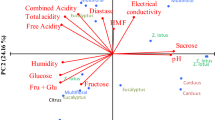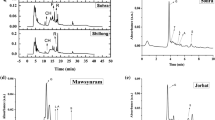Abstract
The physicochemical properties of honey harvested from popular honey-producing areas in Tanzania were investigated. Honey from Shibe-Dodoma had the highest values of specific gravity, total acidity, free fatty acid content, diastatic number, overall acceptability, and lowest hydroxymethyl-furfural (HMF) level as compared to honey samples from other areas. There was no significant difference (p>0.05) in terms of HMF in the other honey samples from Tanga, Morogoro, Same, Arusha, and Tabora. HMF levels in all honey samples were far below the maximum acceptable level of 40 mg/kg as recommended by the Codex Alimentarius Commission Standards before storage for 6 months. No traces of streptomycin and phenol were detected in all honey samples. It was concluded that according to the values of the studied quality parameters, the types of Tanzanian honey obtained from the popular honey producing areas may be judged to be of high quality.
Similar content being viewed by others
References
Singh N, Bath PK (1997) Quality evaluation of different types of Indian honey. Food Chem 58(1): 129–133.
Anass T, Diez MJ, Heredia, JF (2003) Palynological, physico-chemical and color characterization of Moroccan honeys: III. Other unifloral honey types. Int J Food Sci Technol 38(4): 395–402.
Perez-Arquillue C, Concello P, Arino A, Juan J, Herresa A (1994) Quality evaluation of Spanish rosemary (Rosomarimus officinalis) honey. Food Chem 51: 207–210.
Ramirez Cervantes MA, González Novelo SA, Sauri Duch E (2000) Effect of the temporary thermic treatment of honey on variation of the quality of the same during storage. Apiacta 35(4): 162–170.
Kamal A, Raza S, Rashid N, Hameed T, Gilani M, Quaresh A, Nasim K (2002) Comparative study of Honey collected from different Flora of Pakistan. OnLine J Biol Sci 2(4): 626–627.
Gupta JK, Kaushik R, Josh VK (1992) Influence of different treatments, storage temperature and period on some physico-chemical characteristics and sensory quality of Indian honey. J Food Sci Technol 29: 84–8.
El-Sherbiny GA, Rizk SS (1979) Chemical composition of both clovers and cotton honey produced in A.R.E. Egypt. J Food Sci 7: 69–75.
Samko MT, Minafequi S, Huidobro JF, Lozano JS (1992) Aging of Honey. J Agric Food Chem 40: 134–138.
Karabournioti S, Zervalaki P (2001) The effect of heating on honey HMF and invertase. Apiacta 36(4): 177–181.
Vinas P, Campillo N, Cordoba H, Candela ME (1992). Simultaneous liquid chromatographic analysis of 5-(hydroxymethyl)-2-furaldehyde and methyl anthranitate in honey. Food Chem 44: 67–72.
AOAC (1995) Official Methods of Analysis, 16th edn. Arlington, VA. Association of Official Analytical Chemists.
Larmond E. (1977) Laboratory Methods for Sensory Evaluation of Foods. Publication 1637. Ottawa, Canada. Canada Department of Agriculture, pp. 57–59.
Minitab Inc. (2000) Minitab 13 for Windows (Version 13.2). State College, Pennsylvania.
Lagrange V, Sanders SW (1988) Honey in cereal-based new food products, Cereal Foods World 33: 833–838.
Abu-Tarboush HM, Kahtani HA, El-Sarrange MS (1993) Floral types identification and quality evaluation of some hone types. Food Chem 46: 13–17.
The Council of the European Union (2002) Council Directive 2001/110/EC of December 2001 relating to honey. Off J Eur Communities L10/47–52.
Rodriguez-Otero JL, Pasero P, Simal J, Cepeda A (1994) Mineral content of the honeys produced in Galicia (North-West Spain). Food Chem 51: 169–171.
Echigo T, Takenaka T (1974) Production of organic acids in honey by honey bees. Agricultural Chem Soc Japan 48: 225–230.
Codex Alimentarius Commission Standards (1981) Codex Standards for sugars, Standard 12-1981. Codex Standard for honey (European Regional Standards) Vol III. FAO, Rome.
Doner LW (1977) The sugars of honey; A review. J Sci Food and Agric 28: 443–456.
Lee HS, Nagy S (1990) Relative reactivities of sugars in the formation of 5-hydroxymethy furfural. J Food Process Preservation 14: 121–178.
Honey Quality and International Standards (1998) Review by the International Honey Commission, Draft CL 1998/12-S of the Codex Alimentarius and Draft 96/0114 (CNS) of the EU.
Author information
Authors and Affiliations
Corresponding author
Rights and permissions
About this article
Cite this article
GIDAMIS, A.B., CHOVE, B.E., SHAYO, N.B. et al. Quality Evaluation of Honey Harvested From Selected Areas in Tanzania With Special Emphasis on Hydroxymethyl Furfural (HMF) Levels. Plant Foods Hum Nutr 59, 129–132 (2004). https://doi.org/10.1007/s11130-004-0020-7
Issue Date:
DOI: https://doi.org/10.1007/s11130-004-0020-7



